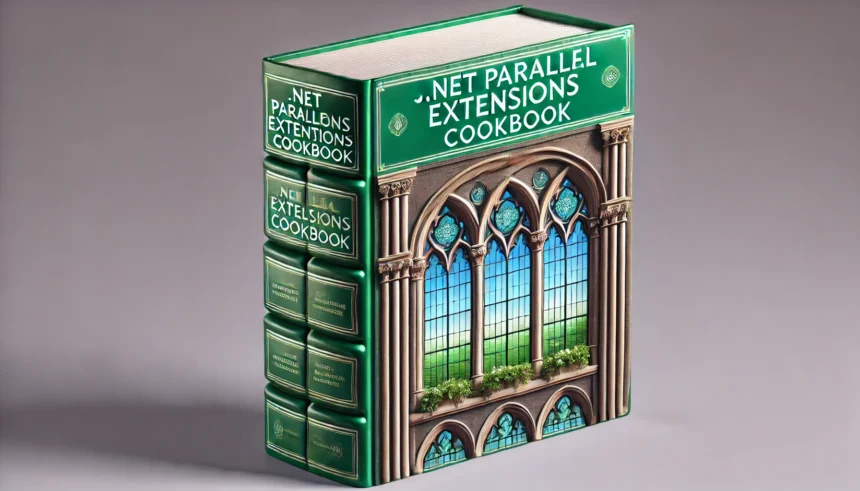Parallel programming is a vital skill for developers aiming to build high-performance, scalable applications. In the world of .NET, the .NET Parallel Extensions Cookbook is a highly recommended resource for mastering parallelism. Whether you’re a beginner or an experienced developer, this cookbook helps you harness the full potential of the Task Parallel Library (TPL) and Parallel LINQ (PLINQ) to solve real-world performance problems.
In this article, we’ll dive into what the .NET Parallel Extensions Cookbook offers, explore key concepts and ingredients behind parallel programming in .NET, and evaluate its effectiveness through real-world examples and user feedback.
What are .NET Parallel Extensions?
Overview of Parallel Programming in .NET
The .NET Parallel Extensions refer to a set of APIs that make it easier to implement parallel and multi-threaded programming within the .NET framework. These extensions allow developers to harness multiple cores and processors in a machine to execute tasks concurrently, significantly boosting the performance of applications.
By using parallel programming, you can optimize tasks such as data processing, file I/O, or complex mathematical computations. .NET Parallel Extensions Cookbook is a comprehensive guide that helps you implement these techniques using tools like the Task Parallel Library (TPL) and Parallel LINQ (PLINQ).
Why Developers Need the .NET Parallel Extensions Cookbook
The .NET Parallel Extensions Cookbook is specifically designed for developers who want to improve their skills in parallel programming. It covers everything from basic concepts to advanced techniques, providing practical, hands-on examples and best practices. Whether you are building a high-performance application or just starting with multi-threading, this cookbook is a must-have resource.
Key Concepts in the .NET Parallel Extensions
Task Parallel Library (TPL)
One of the core components of the .NET Parallel Extensions Cookbook is the Task Parallel Library (TPL). The TPL makes it easier for developers to perform parallel operations. Instead of writing complex multi-threaded code, TPL abstracts much of the complexity with simple APIs, making it easier to create and manage asynchronous and parallel tasks.
The cookbook provides detailed examples of how to use TPL for tasks such as:
- Parallel loops
- Task-based asynchronous operations
- Task scheduling and cancellation
Parallel LINQ (PLINQ)
Parallel LINQ (PLINQ) allows you to query collections in parallel. PLINQ automatically divides the workload across multiple processors to improve performance, especially when dealing with large datasets.
The .NET Parallel Extensions Cookbook offers practical examples of how to use PLINQ to speed up operations like filtering, grouping, and aggregating data. It also explains how to handle exceptions and how to manage the degree of parallelism for optimal results.
Data Parallelism and Multi-core Processing
With the rise of multi-core processors, .NET Parallel Extensions Cookbook teaches developers how to exploit parallelism in data-heavy applications. By breaking down tasks into smaller, independent operations that can run simultaneously on different cores, you can process large volumes of data faster than traditional sequential methods.
How to Use the .NET Parallel Extensions Cookbook for Real-world Applications
Hands-on Code Examples
The .NET Parallel Extensions Cookbook is packed with practical, real-world examples that demonstrate how to use parallelism in different scenarios. For instance, you’ll learn how to:
- Speed up image processing tasks by breaking them into parallel operations
- Accelerate data analysis by using PLINQ for querying large datasets
- Optimize web scraping operations by performing multiple requests concurrently
These examples are easy to follow and show exactly how parallel techniques can be implemented in real-world applications.
Case Studies and Applications
The cookbook also features case studies where developers have applied parallel programming to solve performance bottlenecks. For example, in data processing applications, parallel algorithms can reduce execution time by orders of magnitude, and in machine learning tasks, parallelism can speed up training times significantly.
Advanced Features of the .NET Parallel Extensions Cookbook
Optimizing Performance with Parallelism
One of the standout features of the .NET Parallel Extensions Cookbook is its deep dive into performance optimization. It doesn’t just teach you how to implement parallelism—it shows you how to use it effectively. By understanding the best practices for handling concurrency, you can avoid issues like race conditions, deadlocks, and excessive memory usage.
Managing Parallel Workloads
The cookbook goes into great detail on how to manage workloads efficiently. It explains how to control the level of parallelism, manage task scheduling, and avoid overwhelming your system’s resources. You’ll learn how to use constructs like the Parallel.For loop, Task.WhenAll, and CancellationToken to manage concurrent tasks and prevent performance degradation.
Exception Handling in Parallel Code
Handling exceptions in parallel programming can be tricky. In the .NET Parallel Extensions Cookbook, you’ll find strategies to handle exceptions in parallel tasks gracefully. The cookbook provides patterns for catching errors in multi-threaded applications and ensures that your program can recover without crashing.
.NET Parallel Extensions Cookbook Reviews
User Feedback and Testimonials
The .NET Parallel Extensions Cookbook has garnered positive reviews from developers across the globe. Many users appreciate its clarity, practical examples, and structured approach. Whether you’re new to parallel programming or looking to deepen your knowledge, readers have found the cookbook to be a valuable resource for improving their coding practices.
Pros and Cons of the Cookbook
Pros:
- Comprehensive coverage of parallel programming techniques
- Clear, easy-to-understand examples
- Real-world case studies for practical learning
Cons:
- Requires basic knowledge of C# and .NET framework
- Advanced topics might be challenging for complete beginners
Who Should Use the .NET Parallel Extensions Cookbook?
Target Audience
The .NET Parallel Extensions Cookbook is ideal for:
- .NET Developers who want to enhance their skills in parallel programming.
- Software Engineers working on performance-critical applications.
- Beginners in multi-threaded programming, who are comfortable with C# but want to understand how to optimize applications using parallel techniques.
When to Use It
This cookbook is particularly useful when:
- Developing applications that need to process large volumes of data.
- Working with performance optimization in high-complexity applications.
- Trying to reduce the time for computations, like simulations or rendering tasks.
Is the .NET Parallel Extensions Cookbook Worth It?
Value for Money
Given its depth and breadth, the .NET Parallel Extensions Cookbook offers excellent value for developers looking to master parallel programming. It provides not just theory but actionable techniques that can be applied directly to production code, making it a worthwhile investment for your professional development.
Final Verdict
If you’re a .NET developer looking to take your skills to the next level, the .NET Parallel Extensions Cookbook is a must-have guide. Its comprehensive coverage, practical examples, and clear explanations make it an invaluable resource for mastering parallel programming in the .NET framework.
Conclusion
In summary, the .NET Parallel Extensions Cookbook is an essential resource for anyone interested in parallel programming with .NET. Whether you’re working on performance-critical applications or learning the ropes of multi-threading, this cookbook provides the knowledge and tools you need to optimize your applications.
If you’re ready to dive deeper into parallel programming, grab a copy of the .NET Parallel Extensions Cookbook today, and start building faster, more scalable applications!
Frequently Asked Questions (FAQs)
What is the .NET Parallel Extensions Cookbook?
The .NET Parallel Extensions Cookbook is a comprehensive guide for developers looking to master parallel programming in .NET. It offers practical examples, tips, and techniques for using the Task Parallel Library (TPL) and Parallel LINQ (PLINQ) to enhance application performance.
How does the .NET Parallel Extensions Cookbook improve multi-threaded programming?
The .NET Parallel Extensions Cookbook simplifies multi-threaded programming by providing easy-to-understand examples and best practices. It helps developers efficiently manage parallel tasks, optimize performance, and handle concurrency issues in .NET applications.
Who should read the .NET Parallel Extensions Cookbook?
The .NET Parallel Extensions Cookbook is perfect for .NET developers at intermediate or advanced levels who want to enhance their parallel programming skills. It’s also suitable for developers working on performance-critical applications.
Does the .NET Parallel Extensions Cookbook include real-world examples?
Yes, the .NET Parallel Extensions Cookbook includes numerous real-world examples, such as optimizing data processing, parallelizing tasks like image processing, and using PLINQ for faster data querying.
Can beginners use the .NET Parallel Extensions Cookbook?
While the .NET Parallel Extensions Cookbook is designed for developers with a basic understanding of C# and .NET, beginners can benefit from its step-by-step explanations and practical coding examples on parallel programming.
Article Recommendations:
Dunbarton Umbagog Gordo Gordo Holts: of Discover the Hidden Gem
Ancient Artz – A Permanent the process of reflection on Humanity Civilization






